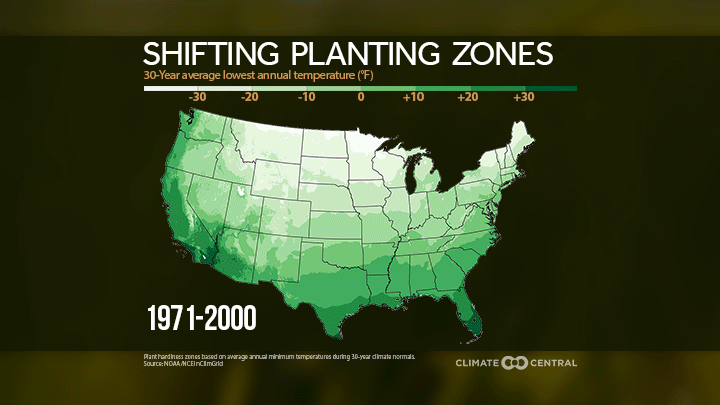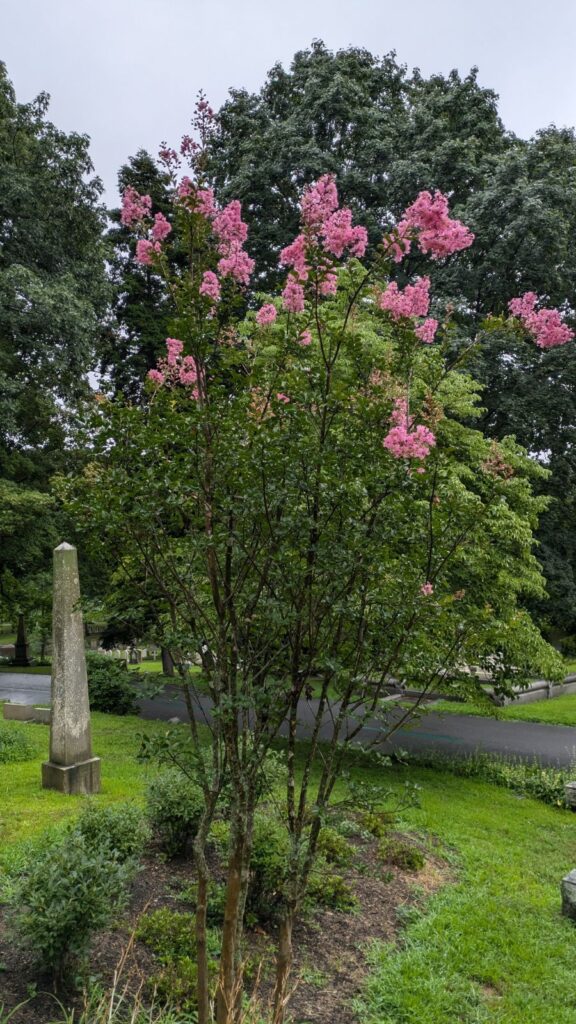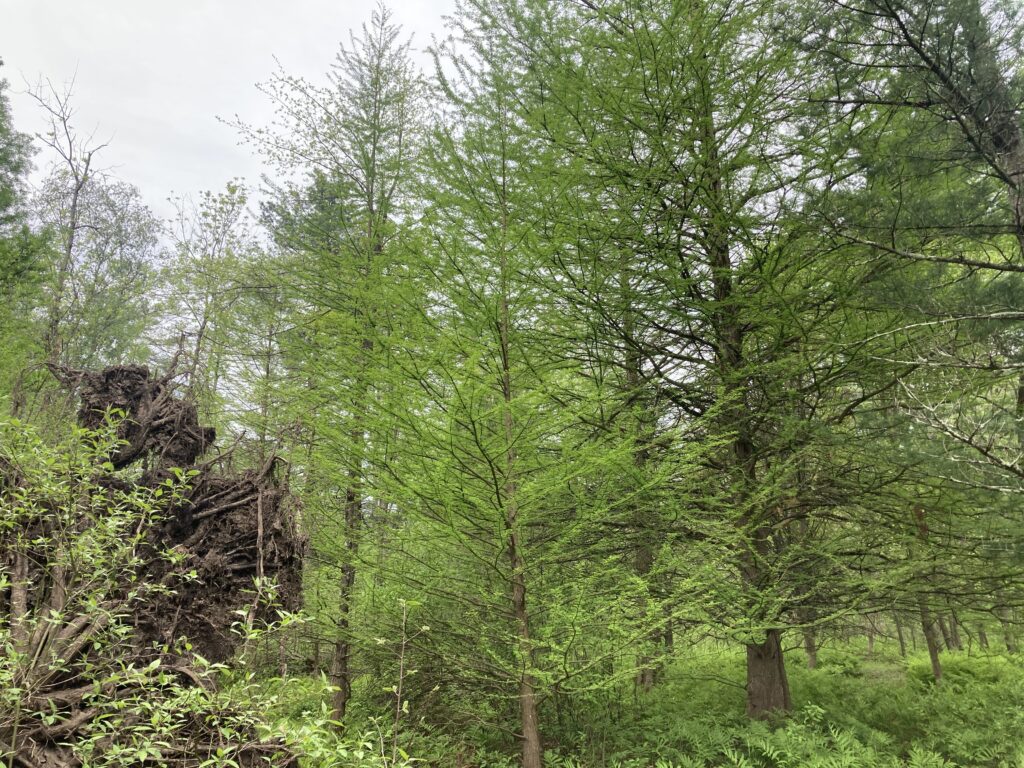Pine Hollow Arboretum’s founder, John W. Abbuhl, began planting trees around his Albany, N.Y., home in the 1960s. He planted species native to surrounding ecosystems but also made ambitious choices—bald cypresses, magnolias, pawpaws, sweetgums—that were more climatically suited to the southeastern United States.
Now, those very trees are thriving, said Dave Plummer, a horticulturalist at Pine Hollow.
Other Pine Hollow trees, such as balsam firs native to New York, have struggled with this century’s warming winters. “We’re noticing they’re not doing as well as they were maybe 5 to 10 years ago,” Plummer said. “These are trees that are just meant to be in more northern climates where the winters are harsher, and we just don’t have those winters [anymore].”
Pine Hollow Arboretum is one of many botanical gardens rethinking their planting strategies as the climate warms. These strategies range from testing out new, warmth-loving plants to putting more resources toward pest and invasive species management.
Planting Zones Shift North
The U.S. Department of Agriculture recognizes 13 plant hardiness zones based on a region’s coldest annual temperatures, averaged over a period of 30 years. These zones guide gardeners’ planting decisions by advising which species of plants, especially perennials, are most likely to thrive in a specific zone.
A new report from Climate Central, a climate change research and communication nonprofit, lays out stark changes to these zones.
Scientists compared 30-year coldest temperature averages from the past (1951–1980) and present (1995–2024) at 247 locations across the United States using NOAA’s Applied Climate Information System dataset. They found that 67% of locations have shifted to warmer zones since the 1951–1980 period.
“The effects of a changing climate on plants and plant communities will be significant and, unfortunately, without precedent.”
They also used the most recently released phase of the Coupled Model Intercomparison Project (CMIP) to simulate how planting zones might shift by mid-century. In the CMIP6 scenario they used, carbon emissions decline but do not stay under Paris Agreement limits, a framework consistent with the Shared Socioeconomic Pathway 2-4.5 “middle of the road” scenario.
The models predict that the mid-century average annual coldest temperatures during the 2036–2065 time period will warm in 100% of the country by an average of 3.1°C (5.6°F). Coldest annual temperatures in the Upper Midwest, Alaska, the Northern Rockies and Plains, and the Northeast and Ohio Valley were projected to warm the most.

Longer Seasons, Looming Threats
The results match what staff at Pine Hollow and Mount Auburn Cemetery in Cambridge, Mass., have seen. At the cemetery (which is also a botanical garden), staff have begun to test whether plants that traditionally couldn’t survive cold Massachusetts winters can now thrive. For example, staff there have begun testing crepe myrtles and paperbush, two flowering shrubs that have survived recent winters.

In Minnesota, plant hardiness zones have shifted by about half a zone since 1951–1980.
Laura Irish-Hanson, an educator and horticulturist at the University of Minnesota, tells students and local gardeners to pay attention to the hardiness map when shopping for perennials and to consider planting species more adapted to warmer climates. “Don’t just look at things that, 200-300 years ago, were native to Minnesota,” she said. “Try things that, historically, maybe are native to Iowa, or Illinois, or parts of Wisconsin that are warmer.”
Mount Auburn is also taking the long view. “The effects of a changing climate on plants and plant communities will be significant and, unfortunately, without precedent,” said Ronnit Bendavid-Val, vice president of horticulture and landscape at Mount Auburn Cemetery, in an email. “We can make informed guesses about a certain plant’s resiliency and toughness based on what is known about its adaptability to extremes in the habitats where its species evolved over millennia. However, horticulturally speaking, ‘plant hardiness’ and fitness can be a vexing subject.”
Anchorage, Alaska, is among the cities that have experienced the largest increase in average annual coldest temperatures, according to the Climate Central report, jumping from −29.8°C (−21.6°F) during 1951–1980 to −24.8°C (−12.6°F) during 1995–2024.
At the Alaska Botanical Garden in Anchorage, hardiness zone changes aren’t the sole climate consequence affecting plants. Will Criner has been gardening there for 12 years as the garden and facilities manager. In that time, he’s noticed the growing season lengthen and, in turn, the time between the first and last frosts dwindle. “We’re definitely seeing a season extension,” he said.
“We can be so frustrated, but then [we should] think of it as an opportunity to try something else, to do something new with that space, and not try to fight with the environment.”
While warming temperatures could expand growing ranges for some specialty, high-value crops like oranges, almonds, and kiwis, they could also expand the ranges of pests. In Alaska, for instance, warmer winters have made it easier for the spruce beetle, a native insect capable of decimating entire tree stands, to thrive, Criner said. And Plummer expects that the spotted lanternfly, an invasive species that threatens fruit and hardwood trees in particular, will become a problem in Albany as its range expands northward.
Warmer temperatures may also make it easier for invasive plant species to establish themselves because they would be able to spread their seeds earlier in the year. Non-native species planted intentionally in gardens may more easily grow out of control, too.
Such non-native species could outcompete other garden plants for water, sunlight, and nutrients, forcing gardeners to change their planting strategies. “I could imagine, as we get longer seasons, that some of these [non-native] plants would have to be removed from our database and deaccessioned” for other plants to thrive, Criner said.
Planting for Precipitation
As the climate warms, gardeners and horticulturists across the country have begun to think about how to better protect their plots.
In the Midwest, gardeners increasingly face oscillating weather conditions—extreme drought and extreme flooding—that can damage and drown plants. That makes gardening even more of a challenge, Irish-Hanson said. For areas facing intensifying rainstorms, water-loving plants can help mitigate damage to a garden, she said, but they must be planted in low-lying spots to receive adequate water.

Plummer, who grew up in Albany, said he’s seen less snow and more ice and wind storms than when he was a child. Those storms can damage plants—a March 2024 ice and wind storm at Pine Hollow Arboretum felled multiple trees, which harmed other specimens. Moving forward, the facility may begin planting species more suited to a warmer climate.
Irish-Hanson recommends gardeners adapt their mindset along with their planting decisions. “Even if we do everything perfectly right and choose the right plant for our environment, it can still die,” she said. “We can be so frustrated, but then [we should] think of it as an opportunity to try something else, to do something new with that space, and not try to fight with the environment.”
Criner has similar advice: “[We should] try to be mindful of the plant choices we make and how plants interact with the surrounding environment, not just if they look pretty or not.”
—Grace van Deelen (@gvd.bsky.social), Staff Writer

